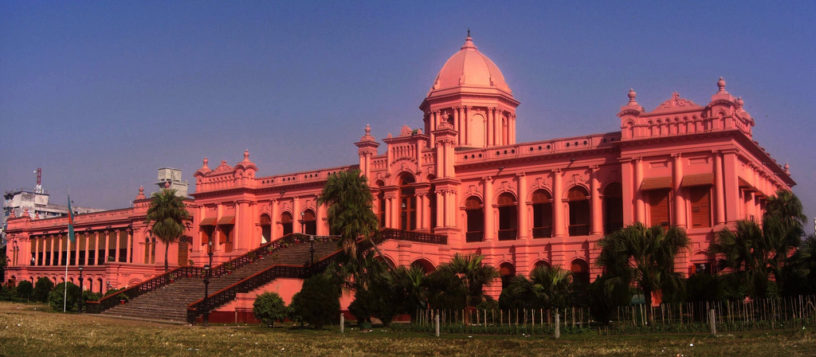Ahsan Manzil

The formal residence palace as well as the seat of the Nawab of Dhaka, Ahsan Manzil was located in Dhaka.
In the city of Dhaka in Bangladesh, the structure may be seen in Kumartoli,
which is located on the Buriganga River's banks. Construction on it began in 1859 and continued until 1872,
when it was finally finished.The building known as Ahsan Manzil was designed and built using the
Indo-Saracenic Revival style. It is now officially a part of the national museum system. During the 14th century,
the city was under the control of the Sultans. Following that, throughout the 17th century,
this location gained prominence as a Mughal capital. In the year 1757, the whole city was under
the control of the British. This Ahsan Manzil was known as Nawab Bari. It was a symbol of nobility, power,
and luxury all rolled into one. In addition, this magnificent construction was the very first building
built in this city that was wired for electrical service when it was completed. People are compelled to visit
this historical area because of its remarkable past, which stimulates and fascinates them.
Construction on the building began in 1859 and continued until it was finished in 1872.It was built
using a style of architecture known as the Indo-Saracenic Revival.
The ancient French building was completely gutted and rebuilt as a two-story structure
that was designed to resemble the Rangmahal. The first levels of the two buildings are
connected by a gangway that was constructed out of wood. The dome, which topped off the already
stunning appearance of the palace, was without a doubt the most stunning creation of this era.
Lalbagh Fort

Dhaka's Lalbagh Fort is a fortified Mughal palace that dates back to the 17th century but was never fully finished. During the Great Rebellion, which occurred in the middle of the 19th century, the Lalbagh Fort was the site of uprisings by local troops against the British. However, these uprisings were eventually unsuccessful.
In 1677, at the height of the Mughal Empire, Prince Muhammad Azam placed the order for the construction of Lalbagh Fort. Soon after construction started, Prince Muhammad Azam departed Dhaka to join his father Emperor Aurangzab in Delhi. He traveled there from Dhaka. Shaista Khan, the new ruler of Dhaka, took up the project and continued construction until 1684, when his cherished daughter Pari Bibi passed away at the location where she had been working. As soon as Shaista Khan learned of his loss, he put an immediate stop to building, and rumors started to spread that the location was haunted.
After then, nobody bothered to build the fort, and it's still in that unfinished form to this day.
The Mausoleum of Pari Bibi, the Diwan-i-Aam (also known as the Hall of Audience), and the Quilla Mosque are the three major components of the fort that have been finished. The Mausoleum of Pari Bibi is a room constructed of white marble, and the tomb sits in the middle of the room. There is limited access to the room.
In addition, a complex network of subterranean tunnels was completed under the Lalbagh Fort. It is reported that during an event that took place during the Sepoy Revolution in the year 1857, men on both sides entered into the tunnels, but they were never seen again, adding to the mystique and intrigue that surrounds the fort.
The archaeological department of Bangladesh is now responsible for the upkeep of the fort. Lalbagh Fort is one of the most popular tourist destinations in Dhaka; each year, over three million people pay a visit to the fort.
A visit to the Lalbagh Fort, which is only halfway finished, and its well maintained gardens is an excellent way to get away from the noise and activity of Old Dhaka for a while. In the soft light of the early morning, the fort exudes an especially eerie atmosphere.
The Diwan is the only structure in the complex that visitors are permitted to enter. Inside, visitors will find a modest but fascinating museum that showcases Mughal miniature paintings, coins, carpets, and calligraphy, as well as swords and weaponry.
The Lalbagh Fort is often regarded as Bangladesh's most well-known and visited fort.